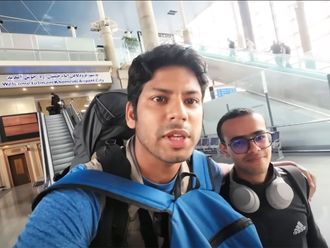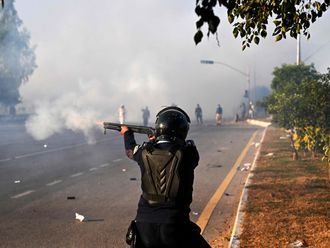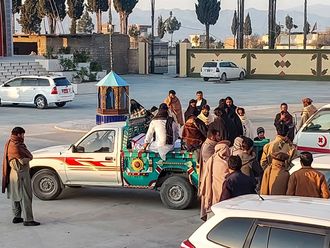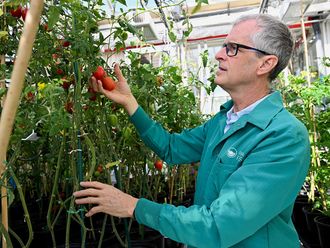
Disclaimer: I am a supporter and voter of Imran-Khan led Pakistan Tehreek-e-Insaf (PTI). I also try, in my limited capacity as a Gulf News columnist and a tweeter, to highlight the positive work being done in Pakistan.
In the case of Punjab’s Chief Minister Usman Buzdar, I have noticed certain consistencies since 2018. Attacks that are relentless. Unsubstantiated criticism that is raucous, shrill. The reasoning supporting the attacks is flimsy if not outright gratuitous. Look-at-the-bad-governance-of-Punjab seems to be the gleeful high-five between anchors of interchangeable sensibilities and PTI-is-bad mantra-parroting opposition politicians and their friends-cum-analysts. Predictions of his removal are weekly news masala. Abundant is the absolute unacceptance of his existence in 8 Club Road without a rational debate on his professional merits and demerits.
How could a rank outsider with negligible administrative experience be given the charge of the largest province of Pakistan is the loud whisper among even some of the prominent members of the ruling PTI; a stark ticker every few hours flashing on millions of TV screens across Pakistan; and an unabashed jibe of a talk show host, an opposition spokesperson, a cynical political analyst, a dynastic politics groupie, an anonymous troll.
Punjab’s Chief Minister Usman Buzdar: the myth versus the reality
The purpose of my interview is not the demystification of an allegedly media-shy, reticent, reclusive politician. Neither is this a rebuttal of attacks on Chief Minister Buzdar–an exercise beyond the scope and intent of the introduction to my interview. His well-behaved, accessible, humble demeanour is noteworthy, but that simply loses its relevance after the introductory exchange if the subsequent conversations or interactions focused on their performance are not effective. A rule that I apply to gauge the professional worthiness of all serving in VVIP positions.
I do not intend to pass any judgment on the politician who is a topic of discussion on many a talk show, on many a timeline. Nevertheless, as a Pakistani, as a Punjabi, and as a resident of Lahore the wellbeing of my country, my province, and my city hold paramount importance to me. The actions of the chief executive of Punjab directly affect, in myriad macro and micro ways, my life, that of my family, and the lives of more than 110 million inhabitants of Punjab. I, therefore, care very deeply about the effects of the governance of the PTI government in all of Pakistan, and more so in Punjab.
My first and the few subsequent meetings with Chief Minister Buzdar were in 2020, and one thing always struck me: how noticeably different he was from the media-created and opposition-caricatured picture. I also found him stoically dismissive of the constant anti-Buzdar media commentary, as he reiterated his resolve to be fully responsible to the five-year assignment given to him by Prime Minister Imran Khan: serve the people of Punjab with the absolute dedication of his office and the complete cooperation of his cabinet, and work for the short- and long-term fulfilment of Prime Minister Khan’s vision to create a Naya Pakistan.
The reason why I contacted the Chief Minister’s Office was to have an opportunity to make a brief chronicle of the real, tangible, people-benefiting work of the PTI’s Buzdar-led government in Punjab. What I present here, through the responses of Chief Minister Buzdar, the work, point-by-point, his government has done since coming into power in August 2018. Simple, direct, unambiguous, two-plus-two-equals-four questions.
On May 18, 2021, I met Chief Minister Usman Buzdar in his office.
Let’s start with the basics. Since you assumed office in August 2018, how many new schools, colleges and universities have been established in Punjab?
Chief Minister Usman Buzdar: Firstly, I would like to thank you for visiting my office on behalf of Gulf News.
Before I elaborate on the reforms in the education sector, let me give you a brief background. It is my sincere belief that PTI’s coming into power was a unique moment in the history of the country when a national leader succeeded in becoming the prime minister after the arduous struggle of 22 years. PTI’s long struggle culminated in success in the general elections of 2018, but I think of it as the first step in a new journey of unquantifiable distance. The process of nation-building, development and prosperity of the country is vastly difficult and complicated.
It is not political rhetoric that PTI inherited a devastated economy and weakened institutions. Decades-long corruption had made the country vulnerable to multiple internal and external challenges including the threat of terrorism. Despite countless hurdles and hardships created by, mainly, meagre resources, the Punjab government has worked hard to improve the provincial governance and economy through sustained and holistic reforms. I would call it a silent revolution at the grassroots as unprecedented steps have been taken in the two and a half years of the PTI tenure.
It is hardly a secret that tall claims were constantly made in the past, but ground realities remained different. Only 1,200 schools were upgraded in the five years of the last regime; the PTI government upgraded 1,227 schools in the first year, and 27,517 schools are being upgraded now. We have made six universities, and eight more universities are in the pipeline. Our plan is to set up a university in every district of Punjab; the previous government established seven universities. 43 colleges formed; 32 more colleges will be completed by June 2021. 205 colleges have been upgraded to the level of Bachelor of Science.
How many new hospitals have been made in Punjab?
Our government has taken several steps to improve the healthcare infrastructure to meet the rising needs of the province. Substantial funds have been allocated to complete the ongoing schemes. The previous governments limited the development process to some specific cities and areas, and a large chunk of the population remained deprived of the fruits of development. But the PTI government following the policy of holistic reforms has employed a composite development strategy to ensure that no one is deprived of the benefits of the governmental reforms.
We have faced a lot of difficulties due to the pandemic, but the government continues to work hard to ensure the best medical facilities for the people of Punjab.
Just to name some of the new projects, Nishtar Hospital II in Multan, Sheikh Zayed Hospital II in Rahimyar Khan, Institute of Cardiology in Dera Ghazi Khan, and Mother and Child Hospital at Sir Ganga Ram Hospital in Lahore are in the process of rapid completion. Eight more hospitals are in the pipeline, including new facilities for mother and child health. Tehsil headquarter hospitals, rural health centres, and basic health units are also being upgraded.
How many shelters have been made in Punjab?
14 shelter homes have been established in various divisional headquarters of Punjab. The scope of this facility, based on Prime Minister Imran Khan’s ehsaas for the underprivileged of Pakistan, is now being expanded to other districts and tehsils.
What steps have you taken for development of agriculture in Punjab?
A synthesised agricultural policy has been introduced for the first time in Punjab. The implementation of the Prime Minister National Agriculture Emergency Programme worth Rs 300 billion is in rapid progress. Model agricultural markets are being set up, and steps have been taken to increase per-acre yield as well as promotion of sowing of oilseed crops. Our government is working to develop a colossal network of watercourses to provide canal water to farmers for agricultural purposes. A subsidy worth Rs 47 billion has been provided to help farmers to procure agricultural machinery. 50 and 60 percent subsidies are provided for the latest drip irrigation and solar systems, respectively.
Our government has also launched the Kisan Card Programme to provide subsidies worth Rs 17 billion to farmers. 8,000 land record centres are being established, 3,000 in South Punjab, for facilitation of the public at their doorsteps.
The agenda of our government is development through institutional reformation.
What steps have you taken for upgrading the irrigation system of Punjab?
Several. Agriculture is the backbone of Punjab, and irrigation is its basic requirement. Irrigation reforms are also important to ensure availability of water for human, livestock, and agricultural needs of water-scarce areas.
I have asked my office to send you the summary of our irrigation projects.
Information provided by CMO:
Rehabilitation of the Trimmu Barrage and Panjnad Barrage located on Chenab River; cost: Rs16,800 million; increased capacity of Trimmu Barrage from 6,45,000 cusecs to 875,000 cusecs to ensure equitable water supply to 1.36 million acres; capacity of Panjnad Barrage from 700,000 cusecs to 870,000 cusecs for improved flood management and uninterrupted irrigation supplies to 1.54 million acres
Rehabilitation and upgradation of the Islam Barrage located on Sutlej river; cost: Rs 2,993 million; increased capacity from 300,000 cusecs to 332,000 cusecs for irrigational supply to 1.0 million acres
115-km-long Jalalpur Canal upgraded to new non-perennial irrigation system for 160,000 agricultural acres in Pind Dadan Khan and Khaushab; cost: Rs 32,721 million
Greater Thal Canal, Chaubara (Phase II) Project to bring 294,110 acres of Thal desert land under cultivation; cost: Rs 16,800 million
Dadhocha Dam for supply of 35 MGD drinking water to residents of Rawalpindi; cost: Rs 6,492 million
Ghabir Dam to tap water in barani areas for irrigation of 15,000 acres and for drinking water in district Chakwal. Cost: Rs 5,655 million
Feasibility study and detailed design of Dera Ghazi Khan and Upper Jhelum canal systems; harnessing of hill torrents potential in Dera Ghazi Khan and Rajanpur districts; Greater Thal Canal Phase III and RQ-QB-BS Link Canals projects
Real Time Flow Monitoring System with 59 stations; 136 data collection points installed on 11 barrages, main and link canals off-taking from barrages and whole Eastern Sadqia Canal System on pilot basis
Water theft curbing campaign in 2019-20; 22,374 water theft cases reported; 6,508 FIRs registered; 2,938 culprits arrested. 9,858 tampered outlets repaired
Introduction of e-procurement and e-tendering to ensure transparency and accountability
Policy initiatives: Punjab Water Policy, 2018; Punjab Water Act, 2019; Punjab Khal Panchayat Authority Act, 2019; Command Area Modification Policy, 2020; Policy for Protections of Local Abadis/Agricultural Lands from Erosive Action of Rivers in Flood Plains; 100 % increase in Abiana rate in 2019, leading to increase in Government of Punjab revenue by Rs 2 billion per annum
What is the update on infrastructure development–new roads, expanded roads, number of kilometres added, new underpasses and flyovers, a better sewerage and waste disposal system in not just Lahore but all of Punjab?
It is an unfortunate reality that maintenance and repairing of roads were wilfully ignored in the past, resulting in the dilapidated condition of various link roads. Our government has initiated the Rural Accessibility Programme Phase I & II to repair 5,000-kilometre-long farm-to-market roads. Road Asset Management System, deflectometer technology and GIS will be utilised to repair and revamp roads. Fast-Falling Land Leveller System will also be applied to devise a foolproof mechanism for repair of roads. Attention is being paid to rectify the designs of the roads that have a high number of accidents.
The Lal Shahbaz Qalandar underpass is complete in Lahore; underpasses and flyovers will be constructed at Shahkam Chowk, Kareem Block Market Chowk and Gulab Devi Hospital Chowk in Lahore. A flyover will also be constructed from the Lahore Railway Station to Sheranwala Gate.
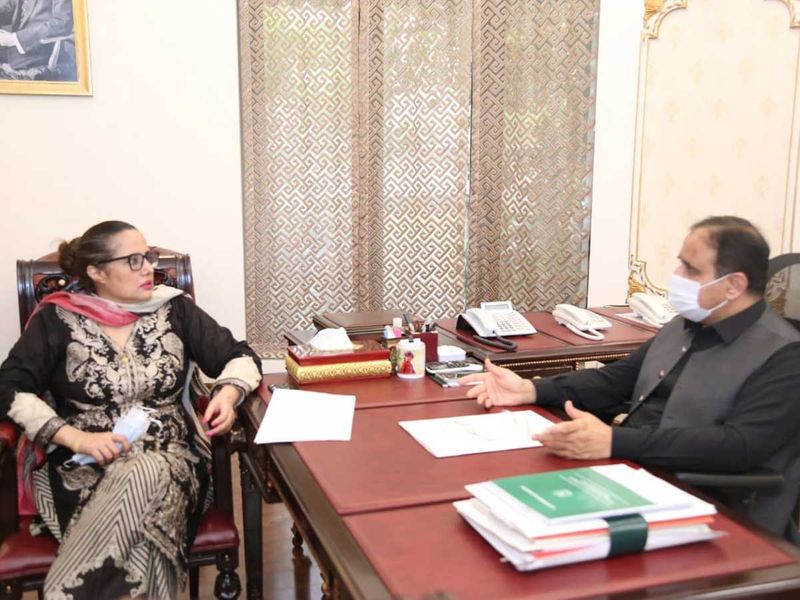
In Lahore, the drainage system is being revamped. Our government has initiated the process of overhauling the water disposal system.
Water supply and drainage systems are being started in different cities. With some foreign aid, the water disposal system is in the process of improvement in Faisalabad, Sialkot, and Sahiwal. Our Punjab Cities Programme is quite helpful for the development of sewerage and sanitation systems in different cities.
What is the update on the availability in Punjab of one of the fundamentals of human existence: clean drinking water?
Punjab Aab-e-Pak Authority has been established to provide clean drinking water to people. This authority is working to install filtration plants in different cities to ease access to clean drinking water.
Unemployment is a huge issue in Punjab. What tangible steps have you taken for the creation of a mechanism that would ensure the availability of jobs and opportunities for employment for millions of unemployed young people of Punjab?
Construction-related activities of our government will create job opportunities in the housing sector. Special economic zones and industrial estates will create ample job opportunities in Punjab. 10,000 constables and 25,000 doctors and paramedics have been recruited by our government. We have also provided jobs to the educated youth in the Border Military Police and Baloch Levies.
In my mind, there is a huge difference between self-employment and working for someone else. Self-employment creates earning opportunities for others too. We have the vision to help the youth to strive for self-employment by providing technical education and other useful courses.
What is the status of your government’s work on prison reforms in Punjab? What are some of the steps you have practically implemented for a) changing the awful conditions of jails in Punjab; b) ensuring justice for inmates jailed on false accusations; c) underprivileged people rotting in jails even after completion of their sentences or/and because of unavailability of funds for bail?
The PTI government has improved the Punjab Jail Manual and introduced jail reforms after a gap of many years. I have also visited many jails to be properly updated about the human and infrastructure issues.
Not only that but we have also ensured the release of prisoners who were unable to pay their fines. Attention has been paid to overcome the system of corruption in jails, and action has been taken against 1,319 employees.
Multi-storey barracks with the accommodation capacity of more than 10,000 prisoners are being made in seven jails. The Prisoners Management Information System has been introduced in 21 jails. A high-security jail in Mianwali and a new prison is being constructed in Lodhran. Complaint boxes in jails have been fixed.
New courtrooms have been set up.
Are you in favour of the local bodies system? If affirmative, what is the reason for delaying local bodies elections?
I started my political career from local bodies, and served as tehsil nazim twice, a position that helped me understand the public issues at the grassroots.
As far as the matter of holding the local bodies elections is concerned, there are some constitutional and legal issues at hand. It is now all sub-judice, and there are no administrative hurdles on the part of the Punjab government.
How much of the government land have you succeeded in recovering from encroachers and land mafias?
A very relevant question. So far 1.6 lakh acres of state land worth 458 billion rupees has been recovered from land grabbers. Rising above all political considerations, across the board action is in progress. There were also some white-collar land grabbers in Lahore and other major cities who used to think they were above the law. It is rather unfortunate that those land grabbers had the patronage of some very powerful political entities.
Vested interests, a weak agricultural and/or distribution policy, or terrible effects of the decades-long governance and corruption–what would you say is the principal reason for the apparent failure of the PTI government to end the domination of all-powerful mafias and cartels controlling the supply, availability, and prices of some essential items like wheat, flour, sugar?
The PTI government is under the courageous leadership of Prime Minister Imran Khan who does not have any ambiguity about acting against any mafia. He is someone who does not succumb to any pressure. Following the vision of Prime Minister Khan, the Punjab government has taken strict action against mafias and cartels involved in the price hike of sugar, flour, and other essential items. This has certainly yielded positive results.
A reminder here that despite the presence of some very strong mafias, the PTI government in Punjab has ensured 99 percent payments to sugarcane growers.
Punjab has been blessed with bumper wheat crops this year, and one of the reasons for that is the timely announcement of the wheat support price. Undoubtedly, this will help to stabilise the flour rate.
The Punjab government has provided 18 items at an identical price in the Ramzan bazaars for three years in a row. Now these markets have been converted to Sahulat Bazaars.
Punjab’s preparedness to deal with the third wave of coronavirus, what are the steps your government has taken for the mitigation of COVID-19 and the certainty of satisfactory following of the preventive SOPs?
Punjab like the rest of Pakistan is facing the third wave of the coronavirus pandemic. Our government has implemented a multifactorial strategy to control the situation for the safety of our citizens. Vaccination began in March, and hundreds of thousands of people have been vaccinated. The Punjab government has allocated Rs 1.5 billion for the procurement of the corona vaccine.
Alhamdulillah, through proper management there is no uncontrollable issue related to oxygen supply in Punjab. Availability of ventilators has also been ensured. More coronavirus testing labs are being set up. Every effort is being made to counter the danger of coronavirus.
Even when the third wave of the coronavirus loses its intensity we will have to learn to live with the disease while strictly following the SOPs. Smart lockdowns are in place and will remain an option as and when required in areas of high-risk infection. Public support is of utmost importance to sensibly fight the horror of COVID-19.
Inflation that literally affects and debilitates the lives of millions of people is a colossal red mark on the almost three-year report of PTI government. How are you dealing with that?
Price-hike is a major issue that has affected the common man, and there are many reasons for this menace. Certain issues are beyond the control of the Punjab government, such as the rate of dollar, and the prices of gas and electricity. But we are not oblivious of our responsibility, and meticulous attention is being paid to find short- and long-term solutions to the issue of inflation. Price-control magistrates are constantly working, and the measures taken against hoarding are yielding positive results.
Chief Minister Buzdar’s competence versus lack of showmanship, solid work versus absence of media savviness, and reality versus perception created by your detractors–what is your take on that?
The reply lies in the question. We are working hard because people have given their mandate to PTI to resolve their problems. Our vision of composite development is our driving force. Finding the best possible solutions of the basic issues is our top priority. I’m keenly aware that trivial things, ultimately, become big problems. We are completely focused on performing and delivering to the masses, but not much attention is given in media to the work done by the PTI government.
If you compare our first three years with those of the previous governments, everything will be crystal clear. In the past, things contrary to the reality were publicised. On example being that the previous rulers used to allocate substantial funds for south Punjab in the annual budgets, but in practical terms, not more than 17 or 18 percent funds were utilised for the development of south Punjab. For ten years, clever political jugglery was used to dupe the people.
Keeping the public fully informed about government’s work is an essential tool of good governance. Are you willing to enhance your media and public interactions for consolidation of your communication of PTI government’s work in Punjab?
Our government is directly connected with the people through media, and other ways. Various steps are taken in accordance with the public opinion. The importance of media is undeniable, and Punjab’s DGPR department is fully active to highlight the programmes and performance of the Punjab government.
We have launched an effective advertisement campaign through print, electronic and social media to educate the people about the coronavirus and other issues. Meetings are regularly held with media persons, and interviews are given to TV channels, newspapers, and magazines. It is the result of this media strategy that today we are in communication with the readers of Gulf News.
At the end of PTI’s term in 2023, what would Chief Minister Usman Buzdar wish his legacy to be?
Punjab is on its way to genuine development and prosperity, inshaAllah. Welfare of the common man is the focal point of our government; the vision of multifaceted development will be implemented through our versatile district development packages. Positive changes, God willing, soon or later, will be visible to everybody. After the completion of PTI’s five-year tenure, the tangible benefits of development will be evident from one end of Punjab to the other, from Attock to Rajanpur.
Our government is focused on the good of all. Our vision is a Naya Pakistan, a Naya Punjab. Serving the people of Punjab, my dream and my goal as the chief minister of Punjab is to ensure a better life for every inhabitant of Punjab. Even the partial fulfilment of that ideal paving the way for a better, a kinder, and an opportunity-filled future would be the legacy I would like to be remembered for. InshaAllah.




